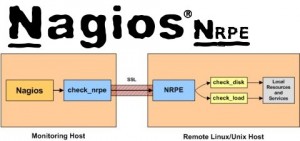Nagios is IT Infrastructure Monitoring Tool. Nagios is designed as a client/server model application and therefore needs two components to work – Nagios server and Nagios client or agent (NRPE for linux or NSClient++ for Windows). Nagios server is the one who connects to Nagios client and triggers a Nagios plugin to get information from Nagios client. Nagios plugin can be any script which can execute on the Nagios client machine (usually perl or bash script). Of course Nagios plugin scripts must be written to output the correct responses and exit codes Nagios server can understand. In this post we will learn how to write bash Nagios plugin script with correct response and exit codes.

Let’s write a Nagios Plugin Bash Script!
Prerequisites:
- Working Nagios Server Instance (Read more here for Ubuntu or CentOS)
- Working Nagios NRPE Client Instance
Important:
- Exit Code 0 = OK
If Nagios plugin script is successfully executed and exits with an exit code 0 then Nagios server will show this check as OK and color it with GREEN color.
- Exit Code 1 = WARNING
If Nagios plugin script is successfully executed and exits with an exit code 1 then Nagios server will show this check as a WARNING and color it with ORANGE color.
- Exit Code 2 = CRITICAL
If Nagios plugin script is successfully executed and exits with an exit code 2 then Nagios server will show this check as CRITICAL and color it with RED color.
Location of Nagios Plugin Scripts:
- If you compiled your NRPE Client yourself the location of Nagios Plugins will probably be: /usr/local/nagios/libexec
- If you installed NRPE Client with YUM or from RPM the location of Nagios Plugins will be: /usr/lib/nagios/plugins
- If you installed NRPE Client with apt-get or from DEB the location of Nagios Plugins will also be: /usr/lib/nagios/plugins
If you agree, it is only fair we put our own Nagios Plugin Scripts in the same directory as other Nagios Plugin Scripts are.
Working Example:
For a working example i have written a simple bash script which checks the number of currently opened files for the specified user with the specified WARNING and CRITICAL threshold. Make sure you will make your Nagios Plugin Bash script executable before you run it! Please note the bolded EXIT CODES in my bash script! You must have lsof installed on your Nagios Client for this script to work (yum install lsof).
#!/bin/bash # Nagios Plugin Bash Script - check_open_files.sh # This script checks the number of currently opened files for the specified user with the specified WARNING and CRITICAL threshold # # Check for missing parameters if [[ -z "$1" ]] || [[ -z "$2" ]] || [[ -z "$3" ]]; then echo "Missing parameters! Syntax: ./check_open_files.sh USER WARNING_THRESHOLD CRITICAL_THRESHOLD" exit 2 fi # Check for number of currently opened files ofiles=$(sudo /usr/sbin/lsof |grep $1 |grep REG |wc -l) # Check if number of currently opened files is lower than WARNING threshold parameter if [[ "$ofiles" -lt "$2" ]]; then echo "OK - Number of open files is $ofiles" exit 0 fi # Check if number of currently opened files is greater than WARNING threshold parameter and lower than CRITICAL threshold parameter if [[ "$ofiles" -gt "$2" ]] && [[ "$ofiles" -lt "$3" ]]; then echo "WARNING - Number of open files is $ofiles" exit 1 fi # Check if number of currently opened files is greater than CRITICAL threshold parameter if [[ "$ofiles" -gt "$3" ]]; then echo "CRITICAL - Number of open files is $ofiles" exit 2 fi
IMPORTANT!! For this script to work properly when run via “check_nrpe” from Nagios Server you must add this line to /etc/sudoers file on the Nagios Client side! This is because of the sudo command used in script.
nagios ALL=(ALL) NOPASSWD:/usr/sbin/lsof,/usr/lib/nagios/plugins/check_ open_files.sh
Test Run:
Let’s test run this script locally from our Nagios Client machine:
[root@foo1 ]# /usr/lib/nagios/plugins/check_open_files.sh Missing parameters! Syntax: ./check_open_files.sh USER WARNING_THRESHOLD CRITICAL_THRESHOLD [root@foo1 ]# /usr/lib/nagios/plugins/check_open_files.sh apache 1200 1400 CRITICAL - Number of open files is 1585 [root@foo1 ]# /usr/lib/nagios/plugins/check_open_files.sh apache 1400 1600 WARNING - Number of open files is 1585 [root@foo1 ]# /usr/lib/nagios/plugins/check_open_files.sh apache 1600 1800 OK - Number of open files is 1585
As we can see our script is covering all of the desired scenarios and the output is as requested by Nagios Server.
Finishing Up:
All we need to do now is to edit the Nagios Client configuration file (nrpe.cfg) and add the new check to it. Our nrpe.cfg line check must include all of the parameters our script requires! We also must add a new service check on Nagios Server side and only then we are done!
Pingback: Pnp4Nagios XML file not found Error - No Graphs | GeekPeek.Net()
Pingback: How To Check If Bash Is Installed On Aix | Wiziri4()